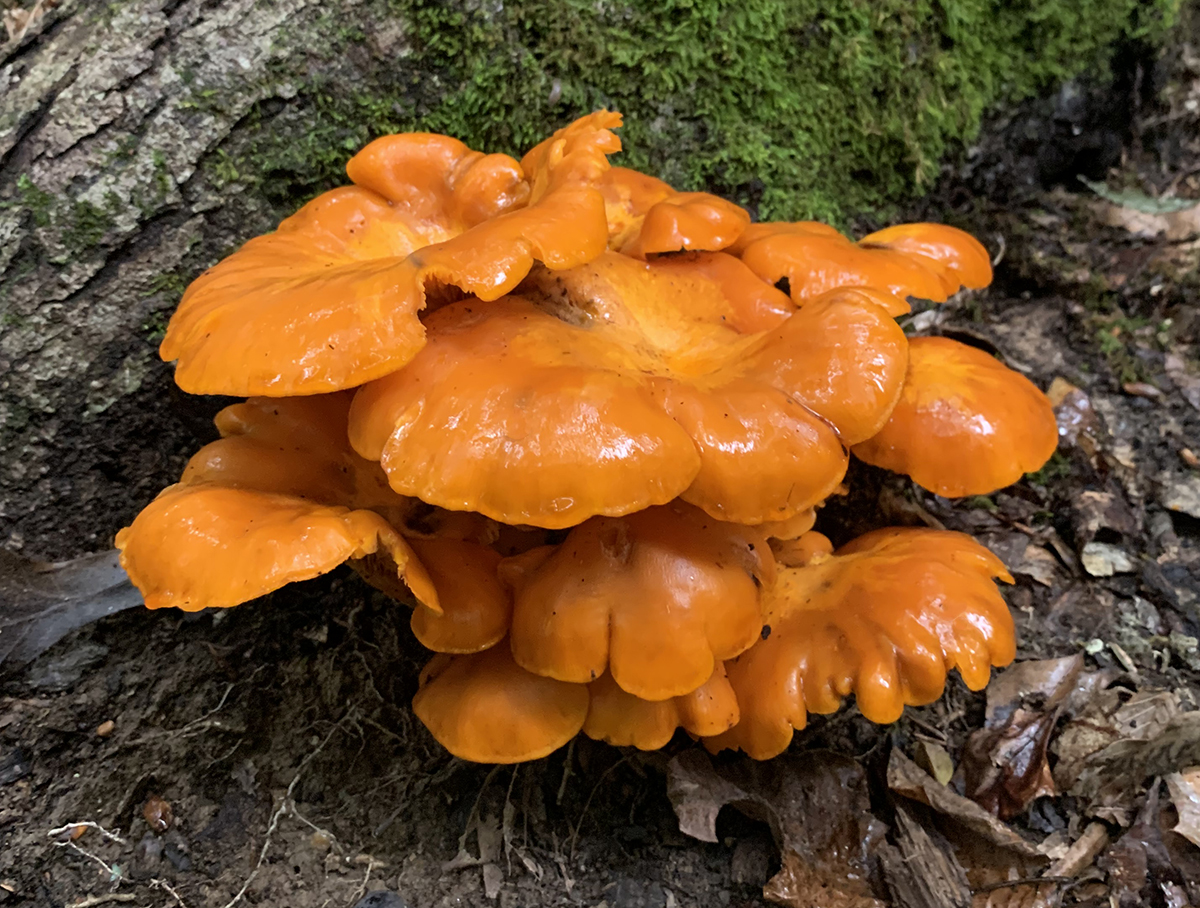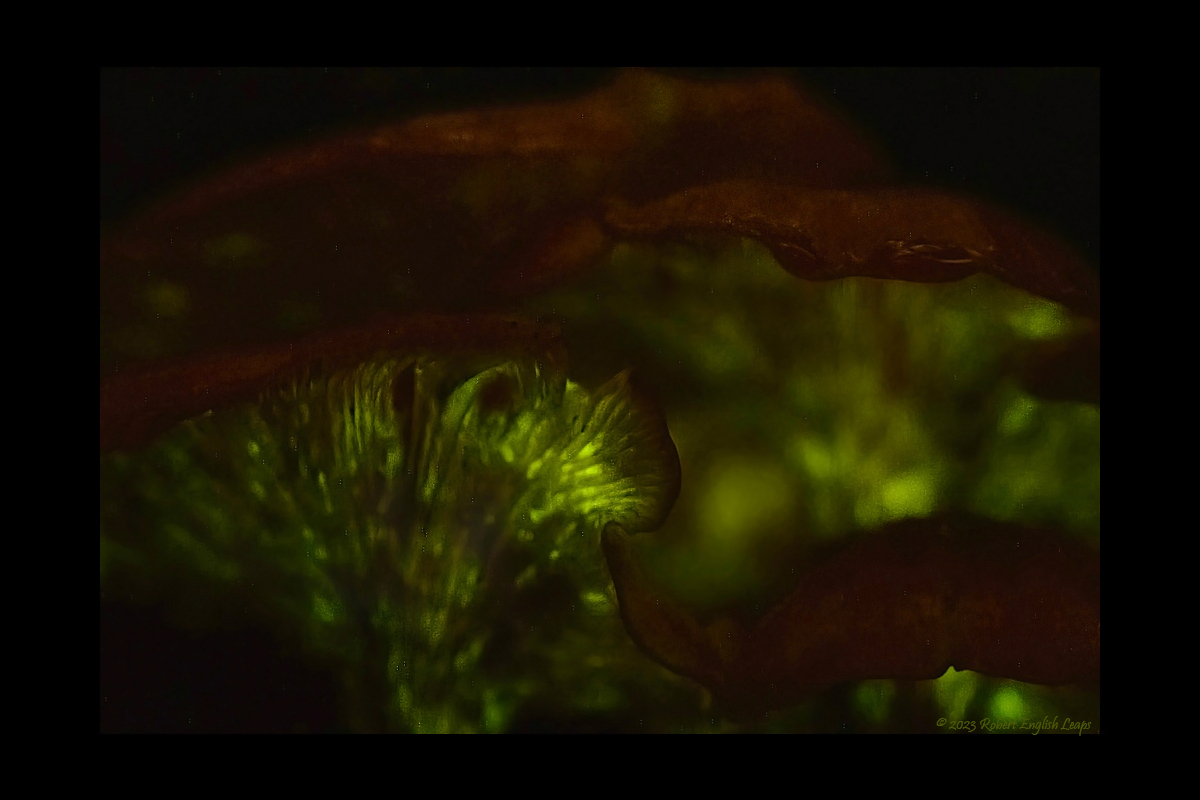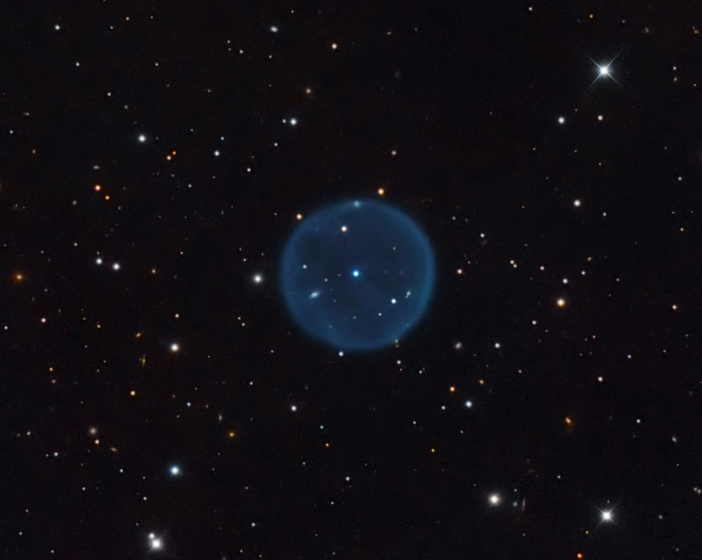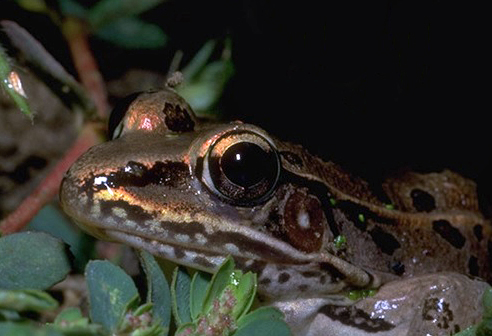The purpose of this feature is to give scout leaders, educators and naturalists an idea of some of the natural events coming up each month. We will try to cover a variety of natural events ranging from sky events to calling periods of amphibians, bird and mammal watching tips, prominent wildflowers and anything else that comes to mind. We will also note prominent constellations appearing over the eastern horizon at mid-evening each month for our area for those who would like to learn the constellations. If you have suggestions for other types of natural information you would like to see added to this calendar, let us know! Though we link book references to nationwide sources, we encourage you to support your local bookstore whenever possible.
Notes From September 2023 On the afternoon of September 9th we came across these Jack-O-Lantern mushrooms on a habitat survey near Dandridge, Tennessee. I've long wanted to see bioluminescence in mushrooms and even though this species is said to be common in the eastern United States in late summer and fall, we've never been in the right place at the right time to see them glow.
What a perfect name for this mushroom! They exactly mirror the color of a Halloween pumpkin and they do shine at night. The original term Jack-O-Lantern was used to describe a visual phenomenon sometimes seen by travelers crossing bogs or mashes at night. They also feature in Irish folklore. Jack-O-Lanterns were originally carved lanterns made from a root vegetable such as a rutabaga or a turnip. Knowing that the glow can be quite faint, we waited until it was completely dark to return to our Jack-O-Lanterns. We took a blanket to shield us from any ambient light. Since it was a cloudy and moonless night, we ended up not needing it. We saw nothing at first, but that was not surprising since our eyes had not dark-adapted and we were looking from above. The caps do not glow, only the gills and stipe. But after just a minute or two of dark adaptation, laying on the ground and looking at the cluster from a foot away, we saw it, faint but unmistakable. The glow was very diffused and colorless to our eyes, just two faint patches of light. No details at all could be seen. By using the amateur astronomer's trick of averted vision (looking to one side of the light source) I could see some brighter spots against one of the glows. This trick works because it lets the incoming light fall on the more light-sensitive rod cells of the eye. In fact, the whole scene in front of us could well have been a faint galaxy seen through one of our telescopes. It was a special moment, and we lay there and savored it for a while. I lacked experience photographing bioluminescence, but decided to give it a try. Having no tripod I wedged the camera and macro lens into a depression in the leaves and started taking test exposures. We held a headlamp on the Jack-O-Lanterns to focus, and this is when things started to become a little more exciting.
The European Hornet is a large non-native hornet first noticed in the United States in the 1940s. We noticed them earlier in the survey seeming to defend certain trees we approached. Though they prey on other insects most of the year, in fall they often incorporate the sugar in fruit or tree sap to their diet. They are attracted to light sources at night, which explains our difficulties with them when we turned on the headlamp to focus the camera. They're over an inch long and are a little intimidating! Two swarmed around us and one stung me on my forearm before we were able to get back to our lights-off mode to take images. I saw absolutely nothing on my first 30-second exposure so I kept cranking up the ISO setting on my camera. The mushrooms need to be very fresh to glow and these were perhaps a bit past their prime. I borrowed another trick from astro-imaging and made not one exposure, but ten exposures one after another with the camera in exactly the same position. You place the images in separate layers in Photoshop, make sure they are aligned, and reduce the second layer's opacity by 50%, the third layer's opacity by 33%, etc. You then flatten the image, resulting in a final image which has a much more accurate average of pixel values, which in turn results in both more detail and less visible noise. I finished taking the last few images as rain began to fall from an approaching thunderstorm. The final image is shown below.
Bioluminescence is a fascinating phenomenon that occurs across a broad spectrum of the natural world. The mechanism for the Jack-O-Lantern bioluminescence is the same as we see in firefly displays; a light-sensitive molecule is acted upon by a an enzyme resulting in a chemical reaction that produces light. In these two examples the light-sensitive molecule is luciferin and the enzyme is luciferase. Both names come from lucifer, which is Latin for "light-bearer". The name was also used by the ancients for the planet Venus when it appears in the morning sky. Venus in the morning sky rises shortly before the Sun, hence the name.
Sky Events for October 2023: An annular Solar Eclipse will occur on October 14th. Its path will take it through the southwest. For details on the eclipse and a map see here. Annular solar eclipses are not visible to the naked eye without filters so they are not as spectacular as total solar eclipses. Morning Sky:
Mercury
will begin the month rising not long before sunrise low in the east. Try
being at your observing spot about 40 minutes before sunrise. It will get
lower to the horizon each day and disappear into the morning twilight as
the month goes on.
Venus is dazzling in the morning twilight!
Anytime before sunrise will give you a good view. It is brighter than all
of the other stars and planets, so the only thing you might confuse it
with will be assigned a flight number and an arrival time.
Evening Sky: Saturn is in the southeast about 24 degrees above the horizon at dusk. This is a terrific time to see Saturn, and it is impressive in just about any telescope. Mid-sized telescopes may show the dark Cassini's Division in the rings.Jupiter rises about an hour and a half after sunset, and on October 1st it will rise alongside the waning gibbous Moon, making it easy to spot. It is well placed for telescopic viewing. For the best views wait till the planet is due south and highest in the sky.
Constellations:
Clear moonless fall nights are a great time to hunt down deep sky objects in Cygnus. The constellation is just about directly overhead and objects like the Veil Nebula or the Cocoon Nebula are at their best. Don't expect to see the bright colors that long-exposure CCD images capture. Above Aldebaran, look for the Pleiades,, a beautiful open star cluster. Also called the "Seven Sisters," it has been known since antiquity. In Japan it is known as Subaru, and the Subaru automobile is named for this cluster. Before the Gregorian calendar reform in 1582, the Pleiades culminated around midnight on October 31st, and it has been traditionally associated with Halloween.
Learning the Constellations:
We advise learning a few constellations each month, and then following
them through the seasons. Once you associate a particular
constellation coming over the eastern horizon at a certain time of year,
you may start thinking about it like an old friend, looking forward to its
arrival each season. The stars in the evening scene above, for
instance, will always be in the same place relative to the horizon at the
same time and date each October. Of course, the planets do move
slowly through the constellations, but with practice you will learn to
identify them from their appearance. In particular, learn the
brightest stars for they will guide you to the fainter stars. Once
you can locate the more prominent constellations, you can "branch out" to
other constellations around them. It may take you a little while to
get a sense of scale, to translate what you see on the computer screen or
what you see on the page of a book to what you see in the sky. Look
for
patterns, like the stars that make up the constellation of Perseus.
The earth's rotation causes the constellations to appear to move across
the sky just as the Sun and the Moon appear to do. If you go outside
earlier than the time shown on the charts, the constellations will be
lower to the eastern horizon. If you observe later, they will have
climbed higher. To observe faint objects, it's always better to wait
until they are high in the sky.
As each season progresses, the earth's motion around
the sun causes the constellations to appear a little farther towards the west
each night for any given time of night. The westward motion of the
constellations is equivalent to two hours per month.
Recommended: A good book to learn the constellations is Patterns in the Sky, by Hewitt-White. For sky watching tips, an inexpensive good guide is Secrets of Stargazing, by Becky Ramotowski.
A good general reference book on astronomy is the Peterson Field Guide,
A Field Guide to the Stars and Planets
, by Pasachoff
. The book retails for around $14.00.
The Virtual Moon Atlas is a terrific way to learn the surface features of the Moon. And it's free software. You can download the Virtual Moon Atlas here. Apps: The Sky Safari 6 basic version is free and a great aid for the beginning stargazer. We really love the Sky Safari 6 Pro. Both are available for iOS and Android operating systems. There are three versions. The Pro is simply the best astronomy app we've ever seen. The description of the Pro version reads, "includes over 100 million stars, 3 million galaxies down to 18th magnitude, and 750,000 solar system objects; including every comet and asteroid ever discovered." A nother great app is the Photographer's Ephemeris. Great for finding sunrise, moonrise, sunset and moonset times and the precise place on the horizon that the event will occur. Invaluable not only for planning photographs, but also nice to plan an outing to watch the full moon rise. Available for both androids and iOS operating systems.Amphibians:
Recommended: The Frogs and Toads of North America, Lang Elliott, Houghton Mifflin Co. Archives (Remember to use the back button on your browser, NOT the back button on the web page!) Natural Calendar September 2023 Natural Calendar February 2023 Natural Calendar December 2022 Natural Calendar November 2022 Natural Calendar September 2022 Natural Calendar February 2022 Natural Calendar December 2021 Natural Calendar November 2021 Natural Calendar February 2021 Natural Calendar December 2020 Natural Calendar November 2020 Natural Calendar September 2020 Natural Calendar February 2020 Natural Calendar December 2019 Natural Calendar November 2019 Natural Calendar September 2019 Natural Calendar February 2019 Natural Calendar December 2018 Natural Calendar November 2018 Natural Calendar December 2017 Natural Calendar November 2017 Natural Calendar October 2017Natural Calendar September 2017 Natural Calendar February 2017 Natural Calendar December 2016 Natural Calendar November 2016 Natural Calendar September 2016Natural Calendar February 2016 Natural Calendar December 2015 Natural Calendar November 2015 Natural Calendar September 2015 Natural Calendar November 2014 Natural Calendar September 2014 Natural Calendar September 2013 Natural Calendar December 2012 Natural Calendar November 2012 Natural Calendar September 2012 Natural Calendar February 2012 Natural Calendar December 2011 Natural Calendar November 2011 Natural Calendar September 2011 Natural Calendar December 2010 Natural Calendar November 2010 Natural Calendar September 2010 Natural Calendar February 2010 Natural Calendar December 2009 Natural Calendar November 2009 Natural Calendar September 2009 Natural Calendar February 2009 Natural Calendar December 2008 Natural Calendar November 2008 Natural Calendar September 2008 Natural Calendar February 2008 Natural Calendar December 2007 Natural Calendar November 2007 Natural Calendar September 2007 Natural Calendar February 2007 Natural Calendar December 2006 Natural Calendar November 2006 Natural Calendar September 2006 Natural Calendar February 2006
Natural Calendar December 2005
Natural Calendar November 2005
Natural Calendar September 2005
Natural Calendar February 2005
Natural Calendar December 2004
Natural Calendar November 2004
Natural Calendar September 2004
Natural Calendar February 2004
Natural Calendar December 2003
Natural Calendar November 2003 Natural Calendar February 2003 Natural Calendar December 2002 Natural Calendar November 2002 Nature Notes Archives: Nature Notes was a page we published in 2001 and 2002 containing our observations about everything from the northern lights display of November 2001 to frog and salamander egg masses. Night scenes prepared with The Sky Professional from Software Bisque All images and recordings © 2023 Leaps
|
|






